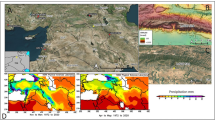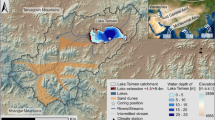Abstract
We inferred the Holocene paleoclimate history of the northeastern Yucatan Peninsula, Mexico, by studying stratigraphic variations in stable isotopes (δ 18O and δ 13C) and lithologic properties (organic matter and carbonate content) in sediment cores taken in 6.3 and 16.2 m of water from Lake Punta Laguna. We present a simple model to explain the lithologic and isotopic variations, and discuss the inferred paleoclimate history in terms of its relation to ancient Maya cultural development. We find evidence for lower lake level and drier climate at about the same time as each major discontinuity in Maya cultural history: Preclassic Abandonment (150–250 A.D.), Maya Hiatus (534 to 593 A.D.), Terminal Classic Collapse (750–1050 A.D.), and Postclassic Abandonment (mid-fifteenth century). Although these broad temporal correlations suggest climate played a role in Maya cultural evolution, chronological uncertainties preclude a detailed analysis of climate changes and archaeologically documented cultural transformations.
Similar content being viewed by others
References
Andrews AP, Andrews EW, Robles FC (2003) The Northern Maya collapse and its aftermath. Anc Mesoam 14:151–156
Anselmetti FS, Hodell DA, Ariztegui D, Brenner M, Rosenmeier M (in prep.) Quantification of soil erosion rates related to ancient maya deforestation
Boose ER, Foster DR, Barker Plotkin A, Hall B (2003) Geographical and historical variation in hurricanes across the Yucatan Peninsula. In: Gomez-Pompa A, Allen MF, Fedick SL, Jimenez-Osornio JJ (eds) The lowland maya: three millennia at the human–wildland interface. Haworth, Binghamton, pp 495–516
Castillo AB, Peraza RLZ (1991) Punta Laguna: Un Sitio Prehispanico de Quintana Roo. Estud Cult Maya 18:23–64
Curtis JH, Hodell DA, Brenner M (1996) Climate variability on the Yucatan Peninsula (Mexico) during the past 3500 yr, and implications for Maya cultural evolution. Quat Res 46:37–47
Dahlin BH (1983) Climate and prehistory on the Yucatan Peninsula. Clim Change 5:245–263
Dahlin BH (2002) Climate change and the end of the classic period in Yucatan. Anc Mesoam 13:327–340
Deevey ES, Stuiver M (1964) Distribution of natural isotopes of carbon in Linsley Pond and other New England lakes. Limnol Oceanogr 9:1–11
Demarest AA, Rice PM, Rice DS (2004) The terminal classic in the Maya lowlands: assessing collapses, terminations, and transformations. In: Demarest AA, Rice PM, Rice DS (eds) The terminal classic in the Maya lowlands. University Press of Colorado, Boulder, Colorado, pp 545–572
Diamond J (2005) Collapse: how societies choose to fail or succeed. Viking, New York, p 575
Dunning NP (1995) Coming together at the temple mountain: environment, subsistence, and the emergence of Classic Maya segmentary states. In: Grube N (ed) The emergence of Classic Maya civilization, Verlag von Flemming, Möckmühl, pp 61–70
Dunning NP, Luzzadder-Beach S, Beach T, Jones JG, Scarborough V, Culbert TP (2002) Arising from the Bajos: the evolution of a neotropical landscape in the rise of Maya civilization. Ann Assoc Am Geogr 92:267–283
Engleman EE, Jackson LL, Norton DR (1985) Determination of carbonate carbon in geological materials by coulometric titration. J Great Lakes Res 2:232–307
Erickson CL (1999) Neo-environmental determinism and agrarian ‘collapse’ in Andean prehistory. Antiquity 73:634–642
Folan WJ (1983) Summary and conclusions. In: Folan WJ, Kintz ER, Fletcher LA (eds) Cobá, a classic Maya metropolis. Academic, New York, pp 211–217
Folan WJ, Gunn J, Eaton JD, Patch RW (1983) Paleoclimatological patterning in Southern Mesoamerica. J Field Archaeol 10:454–468
Giddings L, Soto M (2003) Rhythms of precipitation in the Yucatan peninsula. In: Gomez-Pompa A, Allen MF, Fedick SL, Jimenez-Osornio JJ (eds) The lowland Maya: three millennia at the human–wildland interface. Haworth, Binghamton, New York, pp 77–89
Gill RB (2000) The great Maya droughts: water, life, and death. University of New Mexico Press, Albuquerque, p 464
Gray CR (1993) Regional meteorology and hurricanes. In: Maul GA (ed) Climatic change in the intra-Americas sea. Edward Arnold, London, pp 87–99
Hansen RD (1998) Continuity and disjunction: preclassic antecedents of classic Maya architecture. In: Houston SD (ed) Function and meaning in classic Maya architecture. Dumbarton Oaks, Washington, District of Columbia, pp 49–122
Hansen RD (2001) The first cities – the beginnings of urbanization and state formation in the Maya lowlands. In: Grube N (ed) Maya: divine kings of the rain forest. Konemann-Verlag, Germany, pp 50–65
Hansen RD, Bozarth S, Jacob J, Wahl D, Schreiner T (2002) Climatic and environmental variability in the rise of Maya civilization. Anc Mesoam 13:273–295
Haug GH, Hughen KA, Sigman DM, Peterson LC, Röhl U (2001) Southward migration of the intertropical convergence zone through the holocene. Science 293:1304–1308
Haug GH, Gunther D, Peterson LC, Sigman DM, Hughen KA, Aeschlimann B (2003) Climate and the collapse of Maya civilization. Science 299:1731–1735
Hodell DA, Brenner M, Curtis JH, Medina-Gonzalez R, Rosenmeier MF, Guilderson TP, Chan-Can EI, Albornaz-Pat A (2005a) Climate change on the Yucatan peninsula during the little ice age. Quat Res 63:109–121
Hodell DA, Brenner M, Curtis JH (2005b) Terminal classic drought in the Northern Maya lowlands inferred from multiple sediment cores in Lake Chichancanab (Mexico). Quat Sci Rev 24:1413–1427
INEGI (Instituto Nacional de Estadistica Geografia e Informatica) (1981) 1:1000000 Merida, Carta de Evaportranspiracion y Deficit de Agua, Merida, Yucatan, Mexico
Kelts K, Hsu KJ (1978) Freshwater carbonate sedimentation. In: Lerman A (ed) Lakes: chemistry, geology, physics. Springer, Berlin Heidelberg New York, pp 295–324
Kowalski JK (1994) The Puuc as seen from Uxmal. In: Prem HJ (ed) Hidden among the hills: Maya archaeology of the Northwest Yucatan peninsula. Verlag von Flemming, Möckmühl, pp 99–120
Kowalski JK, Dunning NP (1999) The architecture of Uxmal: the symbolics of statemaking at a Puuc Maya regional capital. In: Kowalski JK (ed) Mesoamerican architecture as a cultural symbol. Oxford University Press, New York, pp 274–297
Lawrence JR (1998) Isotopic spikes from tropical cyclones in surface waters: opportunities in hydrology and paleoclimatology. Chem Geol 144:153–160
Lawrence JR, Gedzelman D, Zhang X, Arnold R (1998) Stable isotope ratios of rain and vapor in 1995 hurricanes. J Geophys Res 103:11382–11400
Leyden BW, Brenner M, Dahlin B (1998) Cultural and climatic history of Coba, a lowland Maya city in Quintana Roo, Mexico. Quat Res 49:111–122
Li H-C, Ku T-L (1997) δ13C–δ18O covariance as a paleohydrological indicator for closed-basin lakes. Palaeogeogr Palaeoclimatol Palaeoecol 133:69–80
Lucerno LJ (2002) The collapse of the Classic Maya: a case for the role of water control. American Anthropologist 104:814–826
Milbrath S, Peraza C (2003) Revisiting Mayapan: Mexico’s last Maya capital. Anc Mesoam 14:1–46
Milne GA, Long AJ, Bassett SE (2005) Modelling holocene relative sea-level observations from the Caribbean and South America. Quat Sci Rev 24:1183–1202
Moholy-Nagy H (2003) The hiatus at Tikal, Guatemala. Anc Mesoam 14:77–83
Perry E, Velazquez-Oliman G, Marin L (2002) The hydrogeochemistry of the karst aquifer system of the Northern Yucatan peninsula, Mexico. Int Geol Rev 44:191–221
Perry E, Velazquez-Oliman G, Socki RA (2003) Hydrogeology of the Yucatán Peninsula. In: Gomez-Pompa A, Allen MF, Fedick SL, Jimenez-Osornio JJ (eds) The lowland Maya: three millennia at the human–wildland interface. Haworth, Binghamton, pp 115–138
Reimer PJ, Baillie MGL, Bard E, Bayliss A, Beck JW, Bertrand C, Blackwell PG, Buck CE, Burr G, Cutler KB, Damon PE, Edwards RL, Fairbanks RG, Friedrich M, Guilderson TP, Hughen KA, Kromer B, McCormac FG, Manning S, Bronk Ramsey C, Reimer RE, Remmele S, Southon JR, Stuiver M, Talamo S, Taylor FW, van der Plicht J, Weyhenmeyer CE (2004) IntCal04 terrestrial radiocarbon age calibration, 0–26 Cal Kyr BP. Radiocarbon 46:1029–1058
Rice PM, Demarest AA, Rice DS (2004) The terminal classic and the “Classic Maya Collapse” in perspective. In: Demarest AA, Rice PM, Rice DS (eds) The terminal classic in the Maya lowlands. University Press of Colorado, Boulder, Colorado, pp 1–11
Robles Castellanos F (1990) La Secuencia Cerámica de la Región de Cobá, Quintana Roo. Instituto Nacional de Antropología e Historia, Mexico, DF
Rosenmeier MF, Hodell DA, Brenner M, Curtis JH, Martin JB (2002) A 4000-year record of environmental change in the Southern Maya Lowlands of Peten, Guatemala. Quat Res 57:183–190
Rozanski K, Araguas-Araguas L, Gonfiantini R (1993) Isotopic patterns of modern global precipitation. In: Swart PK, Lohmann KC, McKenzie J, Savin S (eds) Climate change in continental isotopic records. American Geophyscial Union, Washington, District of Columbia, pp 1–36
Scarborough VL, Gallopin GC (1991) A water storage adaptation in the Maya Lowlands. Science 251:658–662
Suhler C, Ardren T, Johnstone D (1998) The chronology of Yaxuna: evidence from excavations and ceramics. Anc Mesoam 9:167–182
Talbot MR (1990) A review of the palaeohydrological interpretation of carbon and oxygen ratios in primary lacustrine carbonates. Chem Geol 80:261–279
Therrell MD, Stahle DW, Soto Acuna R (2004) Aztec drought and the curse of one rabbit. Bull Am Meteorol Soc 85:1263–1272
Webster D (2002) The fall of the ancient Maya: solving the mystery of the Maya collapse. Thames and Hudson, London, p 368
Willey GR (1974) The classic Maya hiatus: a “rehearsal” for the collapse? In: Hammond N (ed) Mesoamerican archaeology: new approaches. University of Texas Press, Austin, pp 417–430
Yaeger J, Hodell DA (in press) Climate–culture–environment interactions and the collapse of classic Maya civilization. In: Sandweiss DH, Quilter J (eds) El niño, catastrophism, and culture change in ancient America. Dunbarton Oaks, Washington, District of Columbia
Author information
Authors and Affiliations
Corresponding author
Rights and permissions
About this article
Cite this article
Hodell, D.A., Brenner, M. & Curtis, J.H. Climate and cultural history of the Northeastern Yucatan Peninsula, Quintana Roo, Mexico. Climatic Change 83, 215–240 (2007). https://doi.org/10.1007/s10584-006-9177-4
Received:
Revised:
Accepted:
Published:
Issue Date:
DOI: https://doi.org/10.1007/s10584-006-9177-4




